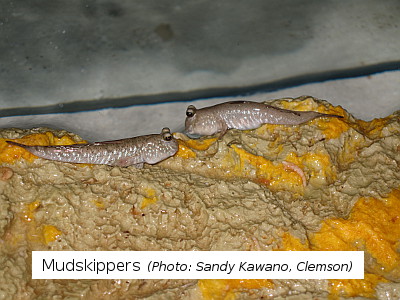SICB Annual Meeting 2013
January 3-7, 2013
San Francisco, CA
Symposium: Vertebrate Land Invasions – Past, Present, and Future
Summary

The transition from water to land was a major evolutionary event in vertebrate history that precipitated a sudden explosion of species diversity. This transition was by no means simple, with the first land animals encountering numerous challenges for movement, support, respiration, osmoregulation, and sensory perception. How did solutions to these challenges evolve?
One avenue for gaining insight into the problems faced by early terrestrial vertebrates is to examine modern species faced with analogous demands. Just as the first sarcopterygian fishes to move onto land may have moved between water and land regularly, many living species of fishes also make use of both aquatic and terrestrial habitats. Similarly, amphibians that regularly move between water and land face the dual functional challenges of the two environments. Studies of such groups have the potential to clarify our understanding of the initial evolutionary terrestrial transition in vertebrates by illustrating the functional demands placed on body systems that must navigate two very different habitats.
But such insights need not run in only one direction. Just as understanding extant systems can inform studies of extinct taxa, studies rooted in evolution and the fossil record can provide new perspectives for studies of modern systems. The functional solutions employed by modern species to bridge aquatic and terrestrial habitats may have deep phylogenetic origins, and may not be the only ones that vertebrates have used during the history of the lineage. Information on past invasions of land may give significant insight into why modern amphibious taxa perform as they do.
Goals
Recent fossil finds and popular accounts of their discoveries have increased public appreciation for the significance of the Paleozoic land invasion. Furthermore, building evidence for the effects of global climate change on environmental conditions has also stimulated greater interest in understanding organism-environment interactions. The goal of our symposium is to bring together a diverse array of scientists at all career stages, spanning fields of paleontology, physiology, behavior, biomechanics, and robotics, to highlight their research in topics related to vertebrate land invasions. We have organized the topics to synthesize a broad body of knowledge about water-land transitions in the distant past and among extant species. We intend this symposium and complementary sessions to point the way to future studies by both promoting integration across perspectives, and by promoting training of the next generation of scientists examining land invasions and environmental change.
Sponsors:
• SICB Society Wide
• SICB Divisions: DVM, DAB, DCB, DCPB, DEDB, DEE, DPCB, DNB
Organizers
- Alice Gibb, Northern Arizona University, Department of Biology, Flagstaff, AZ
- Miriam Ashley-Ross, Wake Forest University, Department of Biology, Winston-Salem, NC
- Richard Blob, Clemson University, Department of Biological Sciences, Clemson, SC
- Tonia Hsieh, Temple University, Department of Biology, Philadelphia, PA
Speakers
S3-1.1 Saturday, Jan. 5, 08:00 COATES, M. I.:
Vertebrate diversity and phylogeny across the fish-to-tetrapod transition
S3-1.2 Saturday, Jan. 5, 08:30 ANDERSON, P*; FRIEDMAN, M; RUTA, M:
Diversity and Disparity of the vertebrate feeding apparatus across the invasion of land
S3-1.3 Saturday, Jan. 5, 09:00 PIERCE, SP*; HUTCHINSON, JR; CLACK, JA:
Historical evolution of early tetrapod movement
S3-1.4 Saturday, Jan. 5, 09:30 DAVIS, Marcus C:
The deep homology of the tetrapod limb: Combining fossil and genetic datasets.
S3-1.5 Saturday, Jan. 5, 10:30 MARTIN, K.L.*; MORAVEK, C.L.; CARTER, A.L.:
Brave New Propagules: Terrestrial Embryos of Aquatic Fish
S3-1.6 Saturday, Jan. 5, 11:00 WILSON, JM*; CHEW, SF; IP, YK:
Metabolic and osmoregulatory challenges of emersion in fishes.
S3-1.7 Saturday, Jan. 5, 11:30 JEW, C.J.*; WEGNER, N.C.; GRAHAM, J.B.:
Physiology in deep time: Using extant vertebrates to model behavioral and functional aspects of the Devonian land transition
S3-2.1 Saturday, Jan. 5, 13:00 VAN WASSENBERGH, S.*; MICHEL, K.:
Feeding and swallowing on land
S3-2.2 Saturday, Jan. 5, 13:30 KNUESEL, Jeremie*; KARAKASILIOTIS, Konstantinos; CRESPI, Alessandro; RYCZKO, Dimitri; CABELGUEN, Jean-Marie; IJSPEERT, Auke Jan:
Gait transitions between swimming and walking in salamander: lessons from numerical modeling and robotics
S3-2.3 Saturday, Jan. 5, 14:00 KAWANO, S.M.*; BLOB, R.W.:
Comparative appendicular function during terrestrial locomotion: implications for the invasion of land
S3-2.4 Saturday, Jan. 5, 14:30 GIBB, A.C.*; ASHLEY-ROSS, M.A.; HSIEH, S.T.:
How is a morphology that is under strong selection for swimming performance “repurposed” for terrestrial locomotion?

Mangrove rivulus (Kryptolebias marmoratus) jumping off of a flat surface.
Photo by Miriam Ashley-Ross and Benjamin Perlman, Wake Forest University, and Alice Gibb, Northern Arizona University

